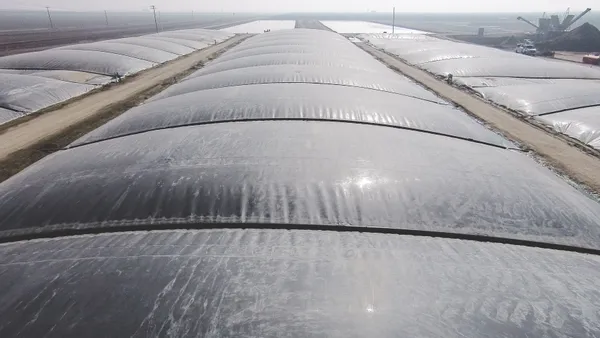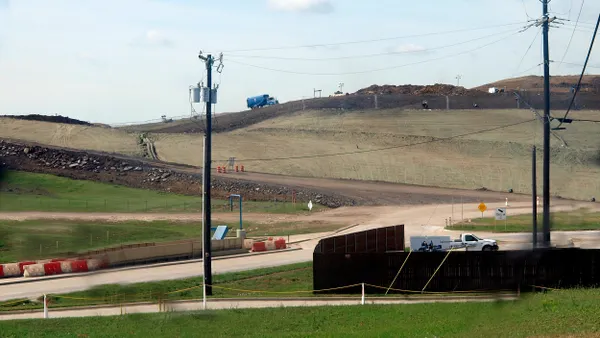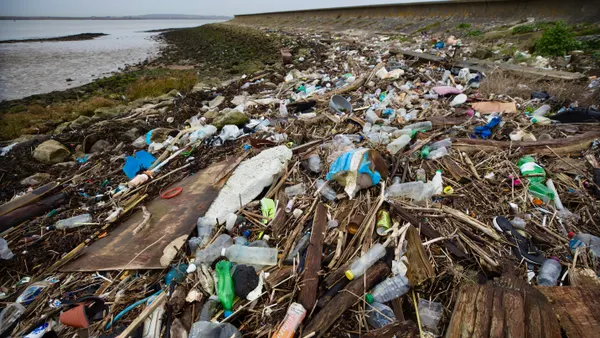Dive Brief:
- The Washington Department of Ecology is preparing to issue a final rule improving landfill gas collection requirements after closing comments at the end of December. The rule would require more landfills to install gas collection and control systems and further tighten responsibilities to manage those systems.
- The change comes as the U.S. EPA and environmental groups found that several of Washington’s landfills were emitting methane above levels that should have triggered action. At one Republic Services owned landfill in Roosevelt, Washington, federal inspectors found 16 points of exceedances during a recent inspection, Grist reported.
- The Department of Ecology received comments from Waste Connections, the Washington Refuse and Recycling Association and several environmental groups. The state agency expects to publish a response and final rule language in March.
Dive Insight:
Landfills are responsible for about 80% of Washington’s industrial methane pollution from large sources according to an analysis of federal data conducted by industrial climate solutions group Industrious Labs. The state’s top three large methane polluters are public landfills in Cowlitz County and King County and Republic Services’ Roosevelt facility, per the analysis. Republic told Grist it had a “differing perspective” to EPA concerning its landfill’s emissions but had “addressed” the agency’s findings.
The rulemaking process began in December 2022. The Department of Ecology was required by statute to consider regulations already in place in other jurisdictions, including the California Air Resources Board’s Landfill Methane Rule. The Washington Refuse and Recycling Association praised Washington for incorporating portions of that rule directly into its own draft rule, while environmental groups urged Washington to go further.
The proposed rule would require all landfills that received waste after Jan. 1, 1992, to install gas collection and control systems. Previously, such systems were required for active landfills with 450,000 tons or more of waste or closed landfills with 750,000 tons or more of waste. Some landfills, such as those receiving hazardous waste or those being regulated under the federal Comprehensive Environmental Response, Compensation and Liability Act, are exempted in the draft rule.
Environmentalists said landfill operators should be required to install gas collection wells earlier than the rule would currently require, citing EPA research that found about half of the emissions from landfilled food waste are released in 3.6 years. They also urged Washington to “strengthen gas collection system and leak monitoring requirements to ensure gas collection system shutdown is minimized and gas collection is robust and comprehensive.”
In the proposed draft language, methane concentrations cannot exceed 500 parts per million by volume as measured by instantaneous surface emissions monitoring or 25 ppmv as determined by integrated surface emissions monitoring.
Any exceedances must be recorded on a map, and operators would need to take corrective action and begin re-monitoring the site of the exceedance within 10 calendar days. Operators are also required to notify authorities within two working days of any actions taken to address exceedances. If a second exceedance is recorded at the same location, operators would be required to take additional action, and a third exceedance would prompt replacement of a problematic gas collection well or alternative measures to address the methane emissions within 120 days.
Multiple waste industry voices took issue with the notification requirements for exceedances and subsequent corrective procedures. In comments, the WRRA said that corrective actions may take multiple days, and its members were still unclear whether that meant they would need to submit multiple notifications for each day the actions were underway. It proposed requiring operators to submit notification if a corrective action was not taken within the proposed time frame, rather than when it was taken.
Landfill operator Waste Connections also took issue with the deadline for action after a third exceedance. The company said inclement weather may delay the construction of a new well, and it proposed language that would allow landfill operators to exceed that timeframe as long as they get written permission from the state.
The monitoring requirement provides exceptions for the working face of a landfill or areas where the cover has been removed to install pollution control systems. The WRRA also proposed allowing for exempted areas like steep or slippery slopes.
The state agency also heard from Sniffer Robotics, whose drones have been approved by the U.S. EPA for landfill monitoring. The company urged Washington to incorporate such technologies as an approved emissions monitoring method. A coalition of environmental groups, including the Environmental Defense Fund, local chapters of 350.org and the Surfrider Foundation, also urged the state to require the use of remote sensing technology, including drones, saying such methods can supplement “current ineffective methods that increase the risk of human error and safety.”
The new rule also includes higher methane destruction efficiency requirements. In the proposed language, landfill gas collection and control systems can use flares with a 99% destruction rate or other technologies that achieve 97% efficiency. Refinement facilities must correspondingly achieve a methane leak rate of 3% or less by weight.
Such systems have to be in operation for at least 15 years, after which quarterly surface emissions monitoring of the landfill must not show methane emission exceedances for two years. The WRRA proposed to shorten that time frame to one year.











